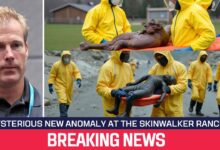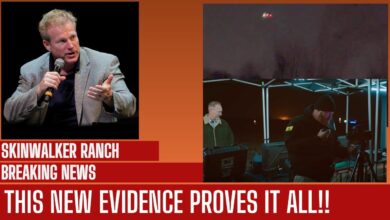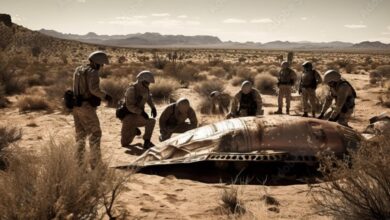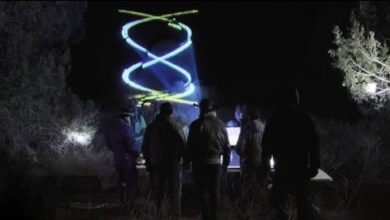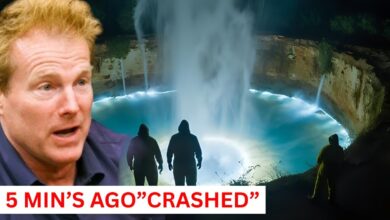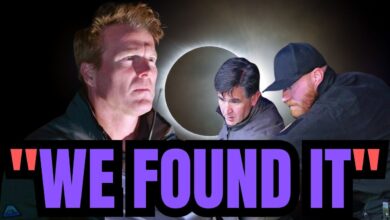Skinwalker Ranch Officials Released New Discovery
Skinwalker Ranch Officials Released New Discovery

Three, two, one.
There it goes. Rockets up. Nothing. I don’t—Nothing should be freaking flying up here in the dark like that.
The entire area was under watch; visible light, infrared, ultraviolet, and thermal spectrums were all being monitored. In addition, the team employed spectrum analyzers, sensitive instruments designed to detect and log signals across the electromagnetic spectrum. These could pick up on strange radio frequencies, spikes in microwaves, or any unexpected electronic emissions.
Radiation detectors were also set to track gamma rays, beta particles, and other ionizing radiation levels. Some of the strangest incidents at the ranch had involved unexplained surges in radiation, particularly around the Mesa and Triangle. GPS devices were mounted to both the burner rig and several points throughout the area to measure distortions in location data. The triangle was infamous for unscrambling GPS coordinates, making it nearly impossible to track objects accurately as they passed through the zone. If any such scrambling occurred during the experiment, it would now be logged in real time.
As the flames continued to blast upward into the mysterious airspace, all eyes were on the screens. Would the anomaly respond? Would a distortion form? Would light bend? Or would an object appear? The expectation was thick. The moment was tense. And then something strange happened.
One of the most ambitious and complex experiments ever undertaken at Skinwalker Ranch was led by Dr. Travis Taylor, a renowned astrophysicist, aerospace engineer, and seasoned investigator of unexplained phenomena. His unique background, which bridges advanced physics, military-grade research, and real-world engineering, made him an ideal figure to tackle the baffling mysteries that had haunted the ranch for decades.
But unlike traditional investigations that sought only to observe, Taylor’s objective was more aggressive: to actively trigger, measure, and document the phenomena reported at the ranch using the most advanced technology available. The scale of the experiment reflected the intensity of the challenge. This wasn’t just another casual inquiry into unusual lights or odd animal behavior. It was a deliberate scientific operation, a full-scale attempt to confront the unknown on its own ground and force it into the light of scrutiny.
Every element of the plan was designed to maximize the possibility of encountering and recording an anomaly in real time. The researchers wanted more than anecdotes and blurry photographs. They wanted hard data, measurable patterns, and undeniable proof of the unexplained.
The team came prepared with a vast array of high-tech equipment. Sophisticated LAR systems scanned the ranch from multiple angles, bouncing light off the terrain to build incredibly detailed 3D maps of areas like the triangle, a known hot spot for aerial phenomena. High-powered thermal cameras were positioned strategically to track heat signatures that might indicate movement or the presence of hidden objects. These devices were capable of detecting temperature differences invisible to the human eye, making it possible to see creatures, crafts, or forces cloaked in darkness, or even camouflage.
Spectrum analyzers continuously monitored a wide range of electromagnetic frequencies in search of spikes, bursts, or interference patterns that might correspond with sightings. In previous investigations, equipment often failed at critical moments, suggesting the presence of electromagnetic disturbances. So this time, Taylor and his team used redundant systems, hardened circuits, and shielded devices determined not to be caught off guard again.
They also employed environmental sensors tuned to measure sudden changes in background radiation, magnetic fields, atmospheric pressure, and even subtle gravitational shifts. Nothing was off limits. If it could be measured, they measured it. And if it couldn’t, they found new ways to try. The approach was comprehensive, blending hard science with the open-mindedness required to face phenomena that didn’t always obey natural laws.
The focus of the experiment zeroed in on three main areas: the East Field, the Triangle, and the Mesa. Each location had a long history of strangeness. The East Field had seen everything from glowing orbs and cattle mutilations to physical effects on the land itself. The triangle, one of the most infamous parts of the ranch, had repeatedly shown bizarre aerial activity, spikes in electromagnetic fields, and what some believed to be the location of a possible unseen gateway or force field. The mesa, towering and weathered, had its own mysteries. Radar imaging and ground-penetrating scans had hinted at massive dense metallic anomalies buried beneath it, structures or objects that defied natural geology. Many believed that something was hidden inside the mesa itself, and Taylor’s team was eager to find out what.
Throughout the experiment, the team was not merely passive observers. They launched rockets into the sky directly above the triangle, a technique designed to provoke a response. If an unknown force was monitoring the ranch or protecting certain areas, they wanted to trigger it. On several occasions, the skies did respond. Objects appeared overhead, some visible to the naked eye, others only captured on infrared or night vision footage. These unidentified aerial objects often maneuvered in ways that defied our understanding of physics, accelerating suddenly, changing direction without inertia, or splitting into two or more separate entities before vanishing altogether.
There were also dangerous side effects. On one occasion, a team member became suddenly ill during a test near the mesa. He reported severe disorientation and pressure in his head. Upon examination, it was discovered he had swelling in his brain, a condition that required emergency medical attention and defied immediate explanation. These physiological effects mirrored earlier cases in the ranch’s history where exposure to certain areas seemed to cause physical harm. Some speculated that this was a natural reaction to electromagnetic radiation or subsonic frequencies. Others believed it might be an intentional defense system, something that didn’t want to be discovered.
The most startling element of the experiment was the way high-tech equipment would still fail, even with all precautions. Devices that worked flawlessly in the lab would inexplicably shut down in the field. Drones would lose connection mid-flight only to return with corrupted data or no footage at all. Cables melted, batteries drained instantly, and sensors gave impossible readings, like gravitational reversals or bursts of ionizing radiation in patterns too deliberate to be natural. Even GPS systems malfunctioned, showing devices hovering in the air or teleporting to impossible locations.
This suggested that the phenomena were not only real, but intelligently reactive, able to respond to observation and possibly manipulate energy, perception, or even matter. Yet, despite the frustration of these anomalies, they were in themselves data. The failures told a story.
Something at Skinwalker Ranch was aware of human presence, reacting to it, and even resisting investigation. It challenged the very principles of scientific inquiry as if it could sense when it was being watched and shift just outside of reach.
Dr. Taylor’s experiment didn’t provide all the answers. If anything, it raised more questions, but it represented a new era of investigation, one in which advanced science, military-grade equipment, and fearless inquiry came together in one of the world’s most mysterious locations.
The findings, though inconclusive in the traditional sense, pointed to one clear fact: Skinwalker Ranch is unlike any other place on Earth. Something happens there. Something intelligent, powerful, and deeply strange. And for every mystery uncovered, three more take its place.
The team left the experiment more determined than ever. The data, the sightings, the biological reactions, the unexplained equipment failures—all pointed to a larger hidden truth waiting to be revealed. It was no longer just about proving the existence of anomalies. It was about unlocking a phenomenon that might lie just at the edge of our understanding. The mission wasn’t over. In fact, it was just beginning.
In the ongoing investigation into the unexplained occurrences at Skinwalker Ranch, the use of cutting-edge technology became not just helpful, but essential. One of the central tools in this endeavor was LAR, light detection and ranging. This advanced remote sensing method gave the team the ability to scan and map the environment with incredible precision.
It works by emitting rapid laser pulses toward the ground and measuring how long it takes for the light to bounce back. With this data, researchers can construct detailed three-dimensional images of the terrain, capturing subtle variations in elevation, contours, and surface features that would be invisible to the naked eye. For a place as mysterious and layered as Skinwalker Ranch, LiDAR was a perfect match.
The ranch spans over 500 acres of rugged terrain, much of it covered in brush, rock formations, and hidden depressions. More than just mapping the landscape, the LAR scans had the potential to reveal what lay beneath it. Any shifts in ground structure, buried metallic objects, or unnatural geometric shapes might become visible when seen through the lens of this technology. Previous scans in certain areas, especially near the mesa and the triangle, had hinted at anomalies, shapes, and densities that didn’t quite belong.
This experiment aimed to go deeper with higher resolution, broader coverage, and a more strategic approach to enhance the visibility and clarity of the LAR readings. The team deployed a dramatic and highly coordinated technique. A hot air balloon burner was used to project enormous blasts of flame into the air during nighttime operations.
The idea was to momentarily light up the terrain with intense bursts of heat and energy while simultaneously scanning with LAR. These fireballs served as both a trigger, potentially provoking a reaction from whatever intelligence might be present, and a lighting source for high-speed cameras operating in night vision, thermal, and infrared modes. By combining different spectrums of observation in one moment, the team increased their chances of detecting something elusive.
The LAR equipment itself was mounted onto a rugged mobile vehicle custom outfitted for this type of terrain. Behind the wheel was John Brown, whose role in navigating the LAR truck was as crucial as the tech it carried. With precise coordination and timing, Brown drove the vehicle across some of the most significant areas of the ranch. These included the East Field, long associated with strange lights and unexplainable electromagnetic spikes, the Triangle, notorious for unexplained aerial phenomena, and the mysterious Conante that had previously appeared in radar scans, and the Mesa drill site, where prior experiments had hinted at large buried objects of unknown origin.
Each location held its own history of strange occurrences. Some recorded on video, others told through whispered stories and urgent eyewitness testimony. The hope was that LiDAR, by stripping away the veil of darkness and top soil, might finally give shape to what had so far remained intangible. Every pass of the LAR truck sent millions of data points back to the team’s computing systems, building intricate models of the surface in real time. Any distortion, void, or sharp unnatural edge was flagged for further investigation.
Adding a unique and critical element to this operation was Cameron Fugle, Brandon Fugal’s brother. He supported the experiment from the air, piloting a helicopter that shadowed the LAR truck from approximately 1,000 ft above the ground.
This aerial perspective wasn’t just for oversight. It allowed for multi-angle triangulation. From that height, Cameron could coordinate aerial visual recording, assist in relaying signals, and potentially spot unusual patterns or objects invisible from ground level. The presence of both land and aerial observation units working in tandem added a new dimension to the investigation, essentially turning the ranch into a layered research grid where every corner was under surveillance and cross-referenced by multiple systems.
As the scans progressed, tension rose. Everyone on the team knew that the phenomena reported at Skinwalker Ranch didn’t always respond to human presence in predictable ways. Sometimes when provoked, the anomalies would emerge suddenly, dramatically, leaving behind scorched marks, sensor malfunctions, or feelings of physical unease in the witnesses. Other times, they would retreat as if waiting for a better moment to show themselves.
The team was not just searching for static objects. They were trying to catch something that might be where it was being hunted. The elusive fing cone, a bizarre vertical energy spike detected previously during rocket launches over the Triangle, was one of the key targets of the LAR scans. The hope was to confirm whether this cone represented a structure in the air, an invisible column or force field, or perhaps a fluctuation in space-time itself. Was it a distortion, a doorway, a projection, or something else entirely?
If the LAR could scan that space precisely while other instruments measured changes in radiation, magnetism, or signal delay, then the team might come one step closer to identifying the true nature of what they were dealing with. But the ranch, true to form, had its own way of responding. On some nights, the data came in clean and rich, showing layers of topography and subsurface anomalies that raised eyebrows and brought renewed excitement. On others, the systems would inexplicably crash or signals would loop back with corrupted files.
Even with the most robust shielding and backup protocols in place, it was as if the very atmosphere of the ranch could bend the rules, sometimes gently, sometimes violently. What LAR offered beyond maps and models was a new angle of attack on the mystery. It allowed the team to see through illusions, whether natural or unnatural. It served not just as a sensor but as a challenge issued to the unknown. Home. We’re watching. We’re measuring. We’re not going away.
As the experiment continued, the data collected began to paint a complex picture. One filled with overlapping layers of geography, energy, and phenomena. It was no longer a question of whether something unusual was happening. The only question left was what exactly it was and whether it wanted to be found.
Cameron Fugle’s role in the ongoing experiment at Skinwalker Ranch was not merely observational. It was pivotal to the success of the entire operation. From his vantage point in the sky, he provided an essential aerial perspective that ensured no part of the target area was overlooked. His mission was to hover 1,000 ft above the ground, precisely aligned with the mobile LAR truck driven by John Brown.
This coordination between air and land wasn’t just about coverage. It was about creating a synchronized, multi-layered scan that could increase the team’s chances of detecting something out of the ordinary. The helicopter’s elevated position offered a sweeping view of the terrain, capturing the full breadth of the East Field, the Triangle, and the edges of the Mesa.
While the LAR truck crawled methodically across the landscape below, firing its laser pulses, and constructing high-resolution 3D maps of every ridge, trench, and indentation, Cameron maintained visual oversight of the broader scene. His position allowed him to detect changes in lighting, energy signatures, or any fast-moving objects that might appear above the ranch, something that had happened during previous experiments when aerial phenomena had manifested in the blink of an eye.
The synchronization between ground-based and aerial teams was seamless. As John Brown navigated the LAR vehicle through predetermined paths, Cameron mirrored his movements from above, relaying observations and coordinating with the command center to ensure that every corner of the scan zone was captured with layered precision.
The LAR technology, sensitive enough to detect minor shifts in terrain, worked in concert with thermal and infrared sensors to form a kind of electronic net—a trap, if you will—designed to catch any anomaly trying to hide in plain sight.
As the LAR sweep gained momentum and data flowed into the command center, anticipation grew. But the experiment wasn’t over. In fact, the next phase was about to begin, and it involved something far more dramatic: a rocket launch.
The rocket was a carefully chosen instrument, not of warfare, but of provocation. The team had theorized that the very act of disturbing the environment in a sudden and energetic way, such as sending a projectile ripping through the sky, might trigger or awaken the phenomena that had so often played cat-and-mouse with them in the past. This idea wasn’t without precedent. Earlier launches had coincided with the sudden appearance of bizarre radar anomalies like the infamous vertical cone over the Triangle, a possible column of energy, or something even more exotic.
Whatever it was, it didn’t appear randomly. It seemed to respond to activity. On the night of the launch, conditions were ideal. Clear skies stretched over the East Field as the rocket stood upright on its launch rail, gleaming under the infrared floodlights. The countdown was given, and the ignition sparked. In a roar of light and sound, the rocket shot into the air, trailing flame and smoke as it arced toward the atmosphere.
All eyes turned skyward. LAR systems engaged to scan not just the surface now, but the airspace around and above the rocket’s trajectory. Infrared and high-speed cameras recorded every frame, searching for changes in heat, light, and motion. From the helicopter, Cameron scanned the air around the rocket’s flight path, watching for anything that might flicker into existence or dart across the sky. The ground team monitored telemetry, triangulating every signal and watching for any deviations, anything unexpected.
In previous launches, sensors had gone haywire. Cameras had shorted out, and radar returns had shown impossible formations. Shapes in the air that were not birds, not aircraft, but something else entirely. This time, the team was better prepared. Systems were hardened against interference. Backups were running in parallel, and every eye, human and electronic, was locked in.
As the rocket soared, the surrounding silence became deafening. People held their breath. Time seemed to stretch as if the ranch itself were waiting to see what would happen next. In those tense moments after the launch, data poured in. Some of it normal, some of it immediately strange. Unexplained heat signatures appeared briefly and vanished. Minor electromagnetic pulses were detected near the mesa. One camera captured a brief distortion in the air. Nothing concrete, but enough to raise the question: did something respond? Was the rocket more than just a test? Was it a message sent and perhaps received?
As the night wore on and systems cooled, the team began to analyze what they had collected. The LAR scans were deep and textured, showing unusual formations below ground, possible voids or structures that didn’t match known geology. The infrared cameras had captured flickers of motion above the Triangle, too fast and too irregular to be birds or insects. And the data from the helicopter showed unusual flight path reflections—not of the rocket, but of something else nearby.
Whether these findings would lead to answers or just more questions was yet to be determined. But one thing was clear. The combination of land, air, fire, and light had stirred something at Skinwalker Ranch. And whatever it was, it had left a trace, one more thread for the team to follow deeper into the unknown.
The launch itself went off without a hitch. The rocket, gleaming under the deep night sky, surged upward in a controlled blaze, and shortly after reaching its apex, deployed its parachute flawlessly. This successful deployment wasn’t just a mechanical win. It was a crucial lynchpin in the entire experiment. With the rocket behaving exactly as planned, the team could proceed with the next phase of their carefully orchestrated investigation without scrambling for recovery or analyzing fragmented data. Every second after that launch mattered.
As the rocket’s vapor trail slowly faded into the sky above the East Field, the next part of the operation snapped into motion. The LAR truck, positioned and ready at the eastern gate, began its crawl across the terrain. John Brown, seated behind the controls, guided the specialized vehicle from east to west, maneuvering with deliberate precision.
Every movement of the truck was part of a detailed path carved into the experiment’s blueprint. Mounted with long-range LAR scanners and a suite of thermal, infrared, and night vision cameras, the truck acted like a rolling probe, peeling back the visual and energetic layers of the ranch.
High above, Cameron Fugle maintained position in the helicopter. At an altitude of exactly 1,000 ft, he hovered directly over John’s LAR truck, forming a vertical scanning corridor that linked the Earth to the sky. From this vantage point, he monitored not just the progress of the ground vehicle, but also the surrounding environment, open sky, shadowy ridges, and the ominous silhouette of the Mesa in the distance.
The coordination between air and land was tight, deliberate. The two men moved like synchronized gears in a larger machine. Each perspective was vital to painting a complete picture of the terrain below. This dual approach—ground-based scanning and aerial oversight—was more than a strategy. It was an immersive multi-angle surveillance system designed to catch what had eluded the team for years.
Phenomena at Skinwalker Ranch had a habit of teasing the boundaries of detection, showing up on one system and vanishing from another, often disrupting the very equipment meant to observe them. This time, the team hoped to trap them in overlapping fields of data.
But as the scan continued and the LAR truck crept steadily westward, a problem emerged. From the ground, everything appeared in order. The truck was following its route, sensors were online, and data was streaming in. But from the sky, Cameron noticed something odd. Despite maintaining what should have been a fixed position directly over the truck, his instruments began indicating a positional discrepancy.
According to flight metrics, he was still above the truck. But when he looked down visually and through sensors, it wasn’t where it should have been. At first, he thought it might be a glitch, a miscalibration between the helicopter’s GPS and the truck’s transponder. But a quick check with the command center confirmed that something was off.
The LAR truck was reporting one set of coordinates, while the helicopter system showed another, separated by a considerable margin—not a few feet, but dozens of meters. It was as if space itself had shifted beneath them. Both systems were correct by their own standards, and yet they disagreed.
This was not the first time spatial inconsistencies had cropped up at Skinwalker Ranch. The area known as the Triangle, in particular, had previously shown signs of warped GPS signals and vertical displacement phenomena—places where altitudes didn’t quite line up, where aircraft instruments faltered, and where drones had gone missing or returned with corrupted telemetry. Was this the same kind of interference, or something new entirely?
The helicopter and LAR team recalibrated, adjusting their positions and verifying their sensor readouts. Still, the discrepancy lingered, and then, as suddenly as it had appeared, it seemed to vanish. The coordinates synced again. Instruments matched. Yet, the data from those anomalous moments was preserved, recorded in full, timestamped, and later cross-referenced with thermal, electromagnetic, and LAR outputs. It showed a brief but measurable distortion, a pocket of inconsistency in the fabric of space over the Triangle captured in the exact window when the rocket had been launched and the scan began.
The rest of the experiment continued, but a new energy gripped the team. This wasn’t just about strange lights or flickers on a screen anymore. They had recorded something physical, something measurable, something that should not have happened under normal circumstances.
Back in the command center, the team poured over the data late into the night. What they had witnessed wasn’t a ghost or a fleeting illusion. It was a spatial mismatch. Technology from two perspectives seeing the same moment differently. A glitch in reality, a manipulation of electromagnetic fields, or something even more elusive. One thing was clear: the ranch had responded. Whether to the rocket’s burst, the layered surveillance, or the very presence of observers looking too closely, it had shifted and for a moment revealed its teeth.
However, as the experiment progressed, something odd began to unfold. Something that defied simple explanations. The team on the ground noticed a puzzling inconsistency between where the helicopter should have been and where it actually appeared to be.
According to Cameron Fugle, who was piloting the helicopter from 1,000 ft above, he was maintaining a steady position directly over the LAR truck as it moved across the ranch. His instrumentation confirmed it. From his vantage point, he was tracking the truck’s path perfectly, hovering above it with precision as they made their way back east, crossing once again over the area known as the Triangle.
Yet, those on the ground saw something entirely different. Looking up, several members of the team clearly observed the helicopter, not directly over the truck as expected, but significantly behind it. In fact, it appeared to be hovering much closer to the Mesa drill site, a notable distance to the west of the truck’s current location.
The discrepancy wasn’t subtle. It was unmistakable. Eyes were checked. Instruments were double-checked. From the ground, the aircraft’s location simply didn’t align with Cameron’s reports.
The initial assumption was that it could be a trick of perspective, an optical illusion caused by angles or the vastness of the terrain. But as the LAR truck moved and the helicopter maintained its supposed overhead position, the visual discrepancy persisted. Everyone could see it.
Cameron continued to insist based on both his instruments and visual reference points that he was flying directly above the truck. Yet from the ground, his chopper remained visibly out of alignment, trailing far behind. The visual and technological data refused to match.
This moment was more than just confusing. It was deeply unsettling. The team began to question whether they were simply misperceiving the helicopter’s position or if something far more unusual was at play. Was the environment somehow distorting their perception? Or was the helicopter itself caught in some kind of spatial anomaly? Could it be that the space around the Triangle was behaving abnormally again, shifting, warping, or even duplicating perspectives in a way no one fully understood?
The implications were heavy. If space or perception could be manipulated, if the very act of observing reality could no longer be trusted, then how could the team hope to measure or document anything with certainty? The confusion over the helicopter’s true position didn’t just add a new anomaly to the list. It challenged the very framework of how they approached observation and data collection.
Cameron’s voice crackled over the radio. “And I’m tracking the truck. I’ve got a clear visual. I’m directly above you guys.”
But to everyone looking up, he wasn’t. The team’s instruments also didn’t seem to fully agree. GPS data from the helicopter matched Cameron’s claims. The LAR system logged the truck’s position accurately, but visually from the ground, the mismatch held. Even attempts to triangulate the position using different tools yielded confusing results. It was as if space itself was skewed, either in a physical sense or through the lens of perception.
This moment drove home a larger truth that had been circling the team’s investigations for years: Skinwalker Ranch resists being understood. It pushes back against observation. It plays with perception, with time, with space. The question was no longer what they were seeing, but how they were seeing it.
With this growing mystery in mind, the team pushed forward to focus on the Triangle itself, a zone of the ranch that had long been associated with bizarre and inexplicable events. Many of the previous phenomena—GPS blackouts, electromagnetic distortions, vertical shafts of radiation, and the infamous inhiker effect—were either centered in or traced back to this triangular area located between the Mesa, the East Field, and the Homestead region.
The Triangle experiment had been designed as a high-stakes probe into this very location. Following the rocket launch and the comprehensive LAR scanning operation, the team set their sights squarely on this enigmatic zone. They hoped that by concentrating energy through coordinated activity, surveillance, and technological triggers, they might coax out a response from whatever intelligence or force was embedded within the land.
This was no simple scientific exercise. It was a direct challenge, an invitation to the unknown. Would the ranch respond again?
As the team moved deeper into the Triangle experiment, their attention zeroed in on a specific vertical region approximately 30 to 31 ft above ground level, an altitude that had shown a history of strange behavior in past investigations. Previous data collected during aerial drone flights and rocket launches had hinted at anomalies in this vertical column of airspace, intermittent radiation spikes, GPS blackouts, and unexplained electromagnetic interference.

